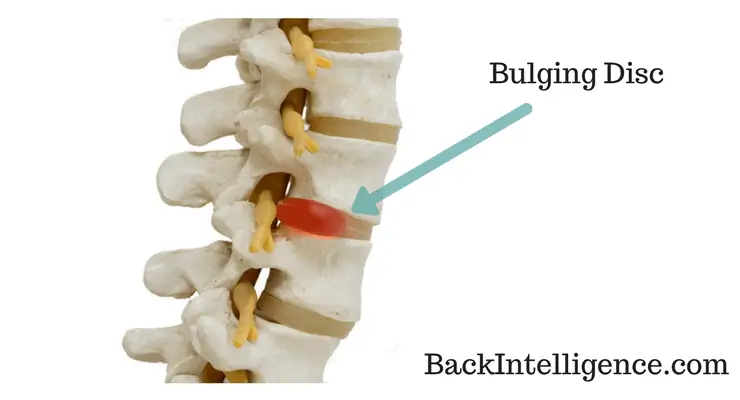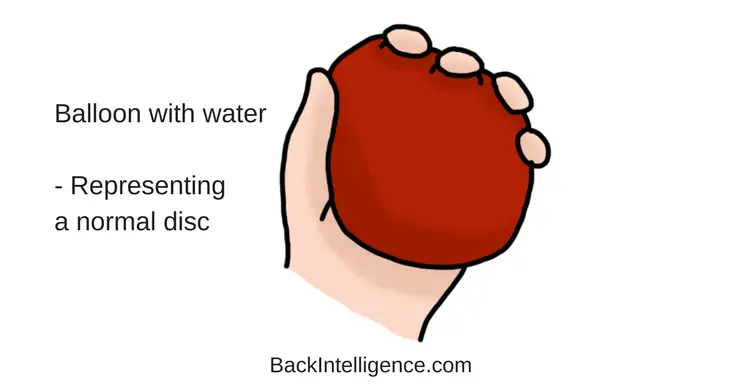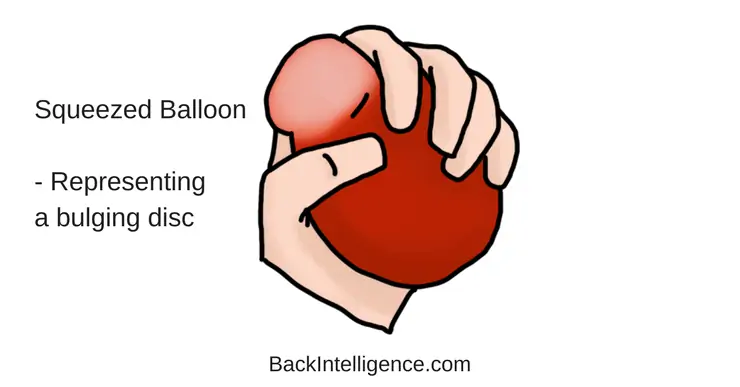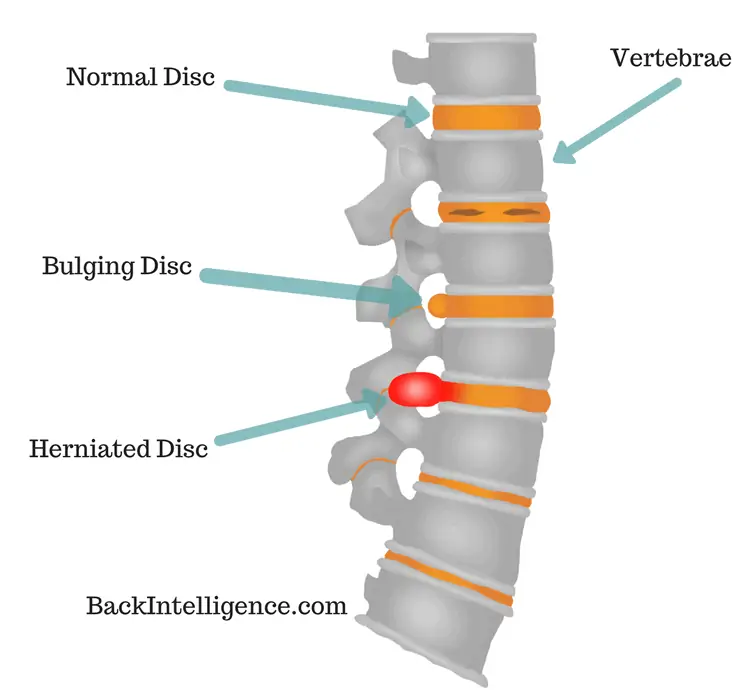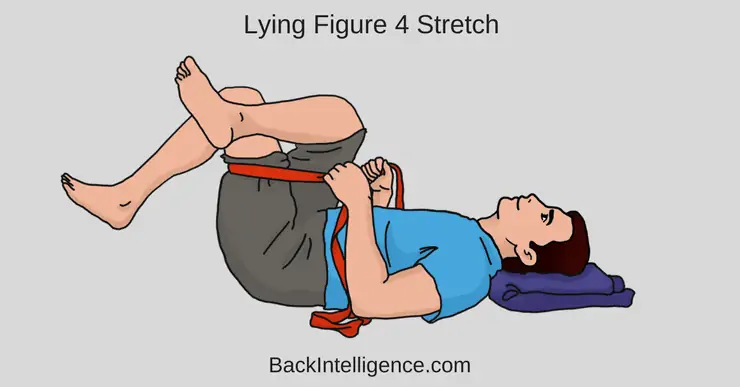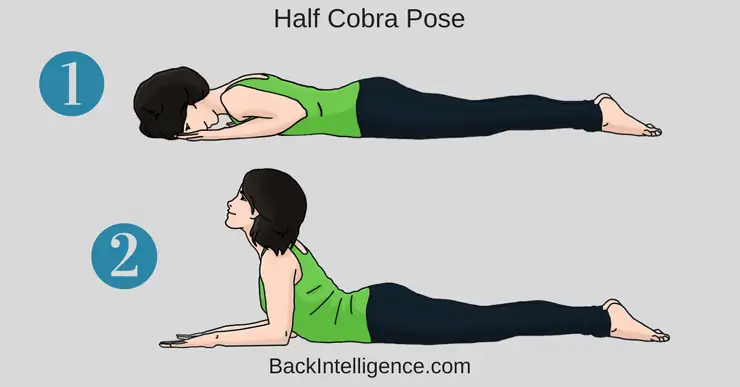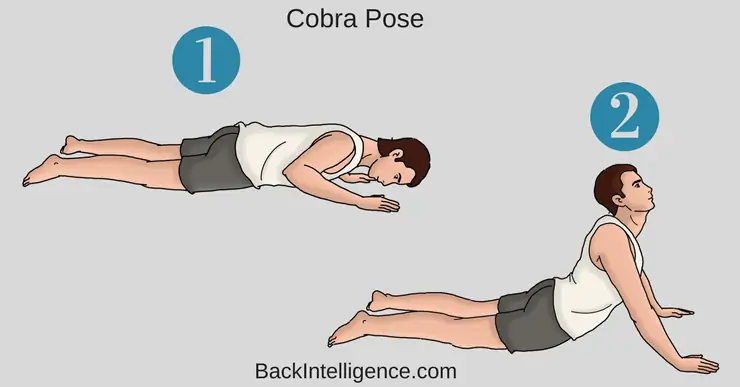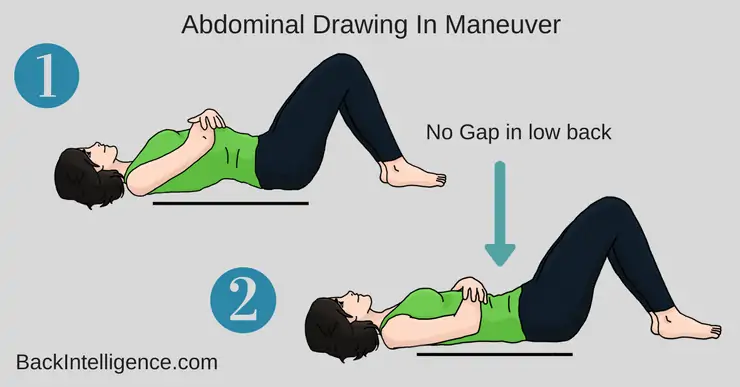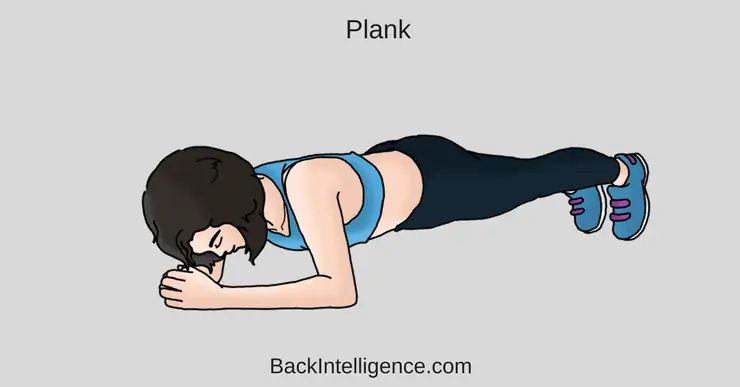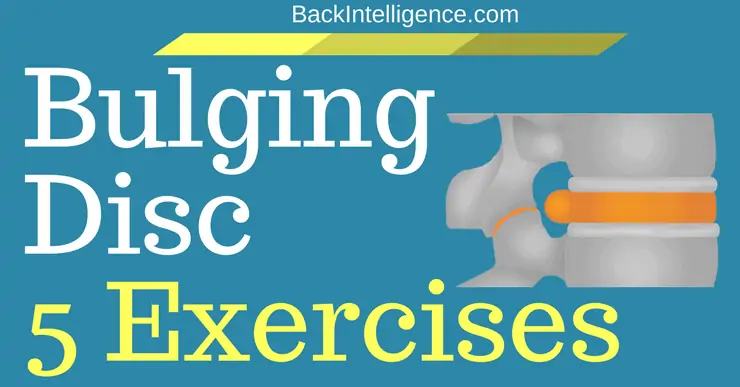
Before we dive into some natural Bulging disc exercises you can do for treatment, let’s explain exactly what a disc bulge is and the main causes.
So, what is a bulging disc?
To understand what a bulging disc is, we must first understand the anatomy of the spine.
Put simply, the spine is made up of individual vertebrae stacked on top of each other. Between each vertebrae is an intervertebral disc that provides a cushion so the vertebrae don’t rub together. The discs between the vertebrae, have a gel-like material inside (called a nucleus pulposus).
A great way to think of the discs is like that of a balloon filled with water, and these discs help resist compressive forces on the spine.
When a disc bulges the gel-like material inside of it gets pushed back towards the nerves and structures of the spine.[2] This bulge can sometimes compress spinal structures, ligaments or nerves in your spine and cause pain, tingling/or burning sensation, and/or other symptoms.[1][3]
* It is important to note that a bulging disc doesn’t always touch the nerves, and for many a bulged disc doesn’t even produce any pain at all.[2][7] However, it could progress to become a herniated disc eventually, which can be problematic.
What Causes a Bulging Disc?
- Sitting for long periods of time, esp in poor posture puts more pressure on the discs.[1]
- Decreased hydration of the disc as one ages (Normal wear and tear).[1][6]
- Repetitive bending, lifting, and twisting (Especially if performed with poor form).[1][6]
- Heavy lifting with poor form due to stress on the front of the spinal column causing the disc to bulge out back.[6]
- Can also result from osteoarthritis or age-related degeneration.[6][8]
- Trauma such as a car accident.[6]
How is a bulging disc different from herniated disc? and which is worse?
Now that we know what a bulging disc is, let’s discuss disc herniation.
● In most simple terms, a herniated disc is when the fluid material from the disc (aka nucleus pulposus) ruptures through the outer layer of the disc (aka anulus fibrosus) and now spills out the back, which can directly compress on spinal nerves and spinal structures. If you use the water balloon example from above, but now imagine the balloon has burst under pressure – That’s a herniated disc.[1][3]
As you can see a herniated disc might be worse. But still many patients with Herniated discs/Bulging discs have NO symptoms, so it’s important to get proper diagnoses for your specific situation.[1]
Usually bulging disc can be resolved over time if managed well, whereas the herniated disc will just scar down since the annulus (outer layer of disc) has ruptured.
A nice visual spine model is provided below differentiating between normal, bulging, and herniated discs: [1][7]
What are the Symptoms of a Bulging Disc in the Lumbar Spine?
- At times NO symptoms at all.[2][7]
- General Low back pain.[4]
- Pain can travel down the leg if it pinches on a nerve.[4]
- Decreased lumbar lordosis (lower back curvature becomes flattened).[6]
- Muscle spasm[4]
What are the most effective treatment options?
With most bulging discs in the lower back, you want to try an extension based exercise program (Mckenzie method is a popular one).[5] This can reverse the direction of the bulge and push the fluid back into neutral alignment. Also, working to strengthen your core is important.
Note: Always monitor your pain severity and location, if these exercises make you feel worse, stop doing them and try a different exercise or consult with your doctor.
Learn More
5 Good Bulging Disc Exercises And Stretches
* Again do them only if you know you have pain because of a disc bulge.
Exercise #1: Lying Figure-4 Stretch (For Piriformis)
In the early stages of a disc bulge, your body’s natural response is to tighten up and protect the spine and buttocks area. Because of this, one of the the simplest things you can do yourself to relieve radiating back pain caused my a disc bulge is stretching piriformis muscle.
How to perform it:
● Begin lying on your back with your knees bent and feet positioned flat on the floor
● Place your right ankle over your left knee
● Use your hands or a band to pull the left thigh towards your chest, and hold for 20 to 30 seconds
● Repeat on the other leg
● Aim for 3 repetitions on each side
Exercise #2: Half Cobra Pose
The half cobra pose creates spinal extension helping push the nucleus (jelly) back towards the center and reduce bulging disc.
How to do it:
● Begin this exercise by lying on your stomach (prone position) and slowly prop yourself up on your elbows while keeping your hips in contact with the floor.
● Hold the prop-up position for 10-15 seconds before returning to the prone position (lying face down).
● Gradually increase to holding the end position for 30 seconds. Aim for 10 repetitions of this stretch.
** Initially, you may not be able to tolerate this position very well, so make sure you start slowly and carefully.
Exercise #3: Full Cobra pose
The full cobra pose creates even more spinal extension than half cobra helping push the nucleus (jelly) back towards the center and reduce bulging disc.
How to do it:
● Begin lying on the ground with your hands flat on the floor at the level of your shoulders
● Slowly push your hands to raise your shoulder off of the ground until you feel a slight stretch
● Increase your range of motion by exhaling as you push further into lumbar extension
● Aim for 5 repetitions
Exercise #4: Abdominal Drawing Maneuver
A solid core foundation helps provide stability which in turn prevents re-injury and further injury from occurring. This will help reset the spine into neutral position.
How to do it:
● lie on your back
● bend your knees
● contract your stomach muscle (Abdominals)
● Hold for 5 seconds
● Release
● Perform 3 x 20 sets daily
Exercise #5: Plank – To Strengthen Core/Abs
This exercise is ideal for strengthening both your deep core and gluteal muscles.
How to do it:
Begin lying on your stomach with your forearms against the mat.
– Engage your core and lift your body so that you are resting on your forearms and toes.
– Ensure that your spine is in a neutral spinal position (not sagging in low back, or lifting butt in the air).
– Hold the plank position for 20-30 sec, Then lower down to floor.
– Aim for 2 to 5 repetitions of this exercise.
** Ensure to keep your back straight throughout the entire exercise.
Other forms of exercise that may help, that were not mentioned above include core strength, walking, pilates, and yoga.
Seeing a primary musculoskeletal care provider is the best approach if your symptoms are not resolving. This includes DO/MD/DC/DPT.
Learn More
Related Articles:
Herniated disc exercises
Spondylolisthesis Exercises
Back pain from sitting – Causes & Treatment
How to fix pain between shoulder blades
What are myofascial trigger points and how to release them
Self Massage Techniques
Spinal Decompression at home
Sources:[1] Humphreys SC, Eck JC. Clinical evaluation and treatment options for herniated lumbar disc. Am Fam Physician. 1999 Feb 1;59(3):575-82, 587-8.
[2] Brinjikji W, Luetmer PH, Comstock B, et al. Systematic literature review of imaging features of spinal degeneration in asymptomatic populations. AJNR Am J Neuroradiol. 2015;36(4):811‐816. doi:10.3174/ajnr.A4173
[3] Low Back Pain Fact Sheet | National Institute of Neurological Disorders and Stroke. Ninds.nih.gov. https://www.ninds.nih.gov/Disorders/Patient-Caregiver-Education/Fact-Sheets/Low-Back-Pain-Fact-Sheet. Published 2020. Accessed May 7, 2020.
Low Back Pain Fact Sheet | National Institute of Neurological Disorders and Stroke.
Dr. Smith earned his Doctorate In Physical Therapy from the University of Miami’s Miller School of Medicine and currently practices as a home care therapist in the Tampa Bay area. He uses his eclectic background of working with everyone from those in the ICU to elite athletes to customize care for each one of his patients and progress them toward their personal goals.
Prior to being a Physical Therapist, he earned a masters degree in public health and managed big pharma clinical trials worldwide. He enjoys CrossFit, Animals, and helping people live a pain free and active lifestyle
